“M-O-L-L-É…”
It is interesting to note that one of radio’s most popular mystery anthologies—The Mollé Mystery Theatre, which debuted over NBC Radio seventy-two years ago on this date—did without its identifying sponsor for a period of three months when it first premiered September 7, 1943. The decision of the “heavier brushless shaving cream” to pick up the advertising tab apparently gave Sterling Drugs (the manufacturer of Mollé) the freedom to attach its name to the program…though when the series migrated to CBS in the fall of 1948, MMT shed the “Mollé” to become simply Mystery Theatre. (It would soon pick up an assortment of different identifiers in its long broadcast history.)
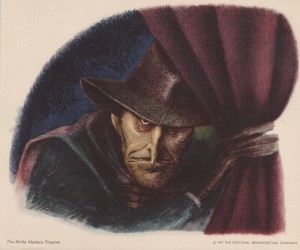 In its original incarnation, The Mollé Mystery Theatre spotlighted tales of mystery cribbed from the works of celebrated authors (from Edgar Allan Poe to Raymond Chandler). The stories were presented through an “annotator” (a fancy description for narrator) who answered to “Geoffrey Barnes”—originally played by Roc Rogers, but Bernard Lenrow is the actor best-remembered in the role. Barnes dubbed himself “the connoisseur of mysteries,” and I’ll bet after his time on the program ended he spent his retirement lunching weekly with Crime Classics’ Thomas Hyland (“the connoisseur of crime”). Okay, I am joking about that—still, Barnes was no slouch when it came to spinning yarns guaranteed to keep listeners on the edge of their seat. When Mollé Mystery Theatre ran dry of inspiration with classic stories, it turned to new contributions from writers who in many instances were making their earliest forays into radio, including Aldous Huxley (“The Giaconda Smile”) and Ray Bradbury (“Killer Come Back to Me”).
In its original incarnation, The Mollé Mystery Theatre spotlighted tales of mystery cribbed from the works of celebrated authors (from Edgar Allan Poe to Raymond Chandler). The stories were presented through an “annotator” (a fancy description for narrator) who answered to “Geoffrey Barnes”—originally played by Roc Rogers, but Bernard Lenrow is the actor best-remembered in the role. Barnes dubbed himself “the connoisseur of mysteries,” and I’ll bet after his time on the program ended he spent his retirement lunching weekly with Crime Classics’ Thomas Hyland (“the connoisseur of crime”). Okay, I am joking about that—still, Barnes was no slouch when it came to spinning yarns guaranteed to keep listeners on the edge of their seat. When Mollé Mystery Theatre ran dry of inspiration with classic stories, it turned to new contributions from writers who in many instances were making their earliest forays into radio, including Aldous Huxley (“The Giaconda Smile”) and Ray Bradbury (“Killer Come Back to Me”).
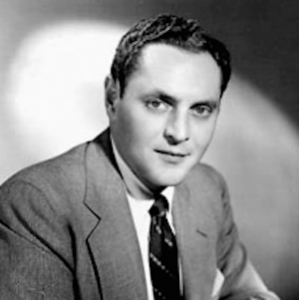 Dan Seymour was the longtime announcer for Mollé Mystery Theatre, and the casts of the various episodes included New York veterans like Joseph Julian, Elspeth Eric, Frank Lovejoy, Anne Seymour and Inner Sanctum’s Raymond Edward Johnson. (A newcomer named Richard Widmark was also a frequent performer on Mollé until he moved on to a lucrative film career pushing old ladies in wheelchairs down staircases.) When Mollé was broadcast on the Armed Forces Radio Service, the name of the sponsor had to be dropped from the title…but they made up for this by adding some real star wattage in Peter Lorre, who became the host of a show alternately known as Mystery Theatre and Mystery Playhouse (an umbrella title for several other radio favorites, too, like Mr. and Mrs. North and The Saint).
Dan Seymour was the longtime announcer for Mollé Mystery Theatre, and the casts of the various episodes included New York veterans like Joseph Julian, Elspeth Eric, Frank Lovejoy, Anne Seymour and Inner Sanctum’s Raymond Edward Johnson. (A newcomer named Richard Widmark was also a frequent performer on Mollé until he moved on to a lucrative film career pushing old ladies in wheelchairs down staircases.) When Mollé was broadcast on the Armed Forces Radio Service, the name of the sponsor had to be dropped from the title…but they made up for this by adding some real star wattage in Peter Lorre, who became the host of a show alternately known as Mystery Theatre and Mystery Playhouse (an umbrella title for several other radio favorites, too, like Mr. and Mrs. North and The Saint).
 In the fall of 1948, CBS began broadcasting the series because…well, because they had been successful in taking everything else from NBC. A slight exaggeration, to be sure, but the program continued on as Mystery Theatre despite the continuing sponsorship of Sterling Drugs (they chose to promote other products such as Bayer aspirin and Phillips Milk of Magnesia). The production of Mystery Theatre was also placed in the hands of Frank and Anne Hummert…who may have been unparalleled in the field of daytime soaps, but unfortunately applied the same heavy-handed melodramatic methods to their mystery shows as well (see Mr. Keen, Tracer of Lost Persons). One of their innovations was to introduce a character entitled Inspector Hearthstone, a dedicated detective played by British actor Alfred Shirley, who worked in the homicide division (nicknamed “the Death Squad”) of London’s Metropolitan Police Department. (It’s speculated that the Hummerts were more comfortable with a solitary protagonist rather than an array of different sleuths week-to-week.) Accompanied by Detective Sam Cook (James Meighan) in his pursuits, Hearthstone made his debut on Mystery Theatre in February of 1949 and by the end of the series’ run, had pretty much taken over the show (only a few broadcasts focused on other characters).
In the fall of 1948, CBS began broadcasting the series because…well, because they had been successful in taking everything else from NBC. A slight exaggeration, to be sure, but the program continued on as Mystery Theatre despite the continuing sponsorship of Sterling Drugs (they chose to promote other products such as Bayer aspirin and Phillips Milk of Magnesia). The production of Mystery Theatre was also placed in the hands of Frank and Anne Hummert…who may have been unparalleled in the field of daytime soaps, but unfortunately applied the same heavy-handed melodramatic methods to their mystery shows as well (see Mr. Keen, Tracer of Lost Persons). One of their innovations was to introduce a character entitled Inspector Hearthstone, a dedicated detective played by British actor Alfred Shirley, who worked in the homicide division (nicknamed “the Death Squad”) of London’s Metropolitan Police Department. (It’s speculated that the Hummerts were more comfortable with a solitary protagonist rather than an array of different sleuths week-to-week.) Accompanied by Detective Sam Cook (James Meighan) in his pursuits, Hearthstone made his debut on Mystery Theatre in February of 1949 and by the end of the series’ run, had pretty much taken over the show (only a few broadcasts focused on other characters).
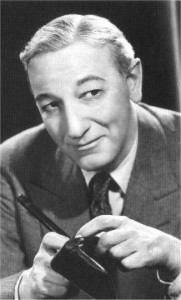 The August 30, 1951 broadcast of Mystery Theatre provided ample evidence of Hearthstone’s successful coup; the show had been retitled Hearthstone of the Death Squad, and it continued on CBS until September the following year—with many of the show’s previous scripts recycled to showcase its new star. Mystery Theatre fans had to tune into ABC Radio beginning in October of 1951 to continue listening to the show made famous by Sterling Drugs’ sponsorship…but they would have been disappointed to discover that the Mystery Theatre anthology had gone the way of Hearthstone by changing its focus to a single protagonist as well. That man was Mark Saber, a detective with the Los Angeles Police Department’s homicide bureau, who solved murders with the help of his sidekick, Sergeant Tim Maloney. (Mark Saber was originally played by Robert Carroll, with Les Damon and Bill Johnstone following; Maloney was essayed by Walter Burke and James Westerfield.) The once-proud Mystery Theatre had morphed into just another hard-boiled detective series—and in fact, was often referred to as Mark Saber or Homicide Squad. It did, however, have the distinction of making the move onto the small screen as Saber of London, telecast on both the ABC and NBC television networks at various times between 1951 and 1960. The radio version closed its case files on June 30, 1954.
The August 30, 1951 broadcast of Mystery Theatre provided ample evidence of Hearthstone’s successful coup; the show had been retitled Hearthstone of the Death Squad, and it continued on CBS until September the following year—with many of the show’s previous scripts recycled to showcase its new star. Mystery Theatre fans had to tune into ABC Radio beginning in October of 1951 to continue listening to the show made famous by Sterling Drugs’ sponsorship…but they would have been disappointed to discover that the Mystery Theatre anthology had gone the way of Hearthstone by changing its focus to a single protagonist as well. That man was Mark Saber, a detective with the Los Angeles Police Department’s homicide bureau, who solved murders with the help of his sidekick, Sergeant Tim Maloney. (Mark Saber was originally played by Robert Carroll, with Les Damon and Bill Johnstone following; Maloney was essayed by Walter Burke and James Westerfield.) The once-proud Mystery Theatre had morphed into just another hard-boiled detective series—and in fact, was often referred to as Mark Saber or Homicide Squad. It did, however, have the distinction of making the move onto the small screen as Saber of London, telecast on both the ABC and NBC television networks at various times between 1951 and 1960. The radio version closed its case files on June 30, 1954.
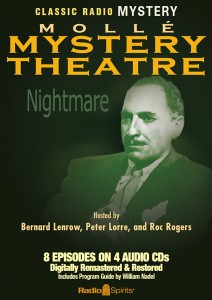 On the Radio Spirits’ horror compilation Great Radio Horror, the Mollé Mystery Theatre is represented with a spine-tingling tale entitled “The Beckoning One” (originally broadcast on June 5, 1945). But devoted fans will want to grab a copy of Mollé Mystery Theatre: Nightmare for their old-time radio libraries—with programs hosted by Roc Rogers, Bernard Lenrow and Peter Lorre, and featuring classics like Cornell Woolrich’s “Nightmare” (brought to the silver screen as the 1947 noir Fear in the Night) and Robert Bloch’s “Yours Truly, Jack the Ripper” (later a memorable episode of TV’s Thriller, hosted by Boris Karloff). The DVD Rare TV Mystery also features an episode of Saber of London from 1952, “The Case of the Locked Room,” with Tom Conway bringing the radio sleuth to boob tube life!
On the Radio Spirits’ horror compilation Great Radio Horror, the Mollé Mystery Theatre is represented with a spine-tingling tale entitled “The Beckoning One” (originally broadcast on June 5, 1945). But devoted fans will want to grab a copy of Mollé Mystery Theatre: Nightmare for their old-time radio libraries—with programs hosted by Roc Rogers, Bernard Lenrow and Peter Lorre, and featuring classics like Cornell Woolrich’s “Nightmare” (brought to the silver screen as the 1947 noir Fear in the Night) and Robert Bloch’s “Yours Truly, Jack the Ripper” (later a memorable episode of TV’s Thriller, hosted by Boris Karloff). The DVD Rare TV Mystery also features an episode of Saber of London from 1952, “The Case of the Locked Room,” with Tom Conway bringing the radio sleuth to boob tube life!

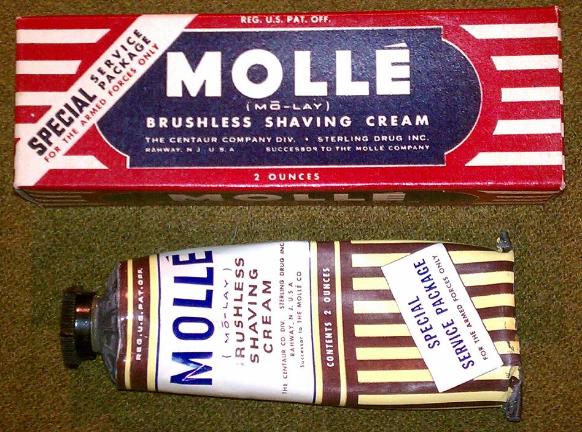

M-O-O-L-E. This was spelled out for the listener, right? Can almost hear it. And I can see Widmark pushing that poor old lady in the wheel chair down the stairs, laughing maniacally. Great actor. Best at nasty parts.
Wonderful article! I’m a Baby Boomer who heard got hooked to old time radio listening to a Radio Spirts broadcast. I really enjoy reading about the history of the programs and actors. Well-done.